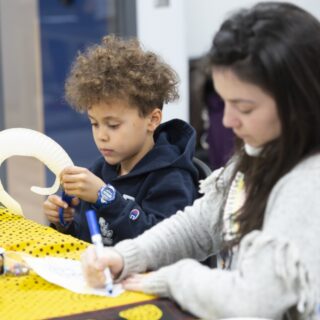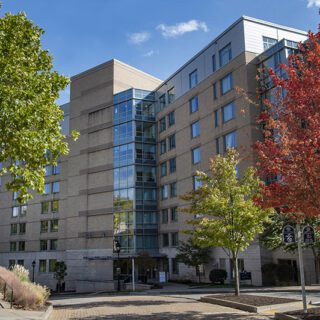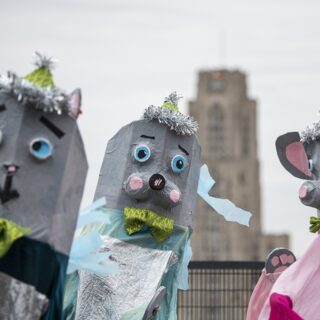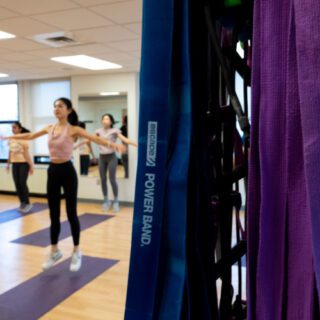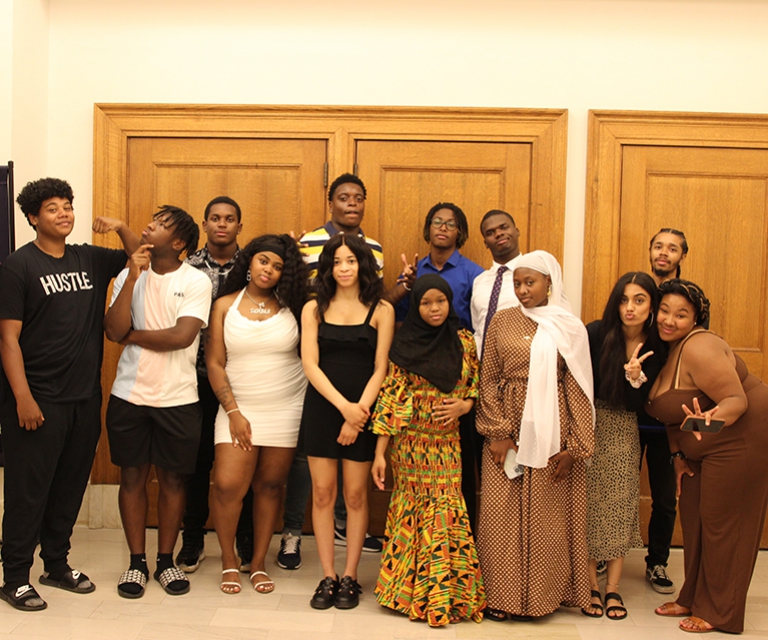
High School Summer Academy Explores Genius, Joy, and Love in Education
As a student in the Genius, Joy, and Love Summer Academy, Taliah Baldwin believes she learned things during the four-week experience that were not taught to her in formal schooling.
“Something I’ve learned from this program is how to be an educator and how to advocate for myself,” says Baldwin, who graduated from Brashear High School in 2022 and who will be attending the University of Pittsburgh at Greensburg this fall. “I’ve learned how to speak up for myself for what I believe in or what I think is wrong.”
Baldwin was one of 14 students from Pittsburgh Public Schools (PPS) who took part in the summer academy, which was created and designed by Valerie Kinloch, Renée and Richard Goldman Endowed Dean and professor at the University of Pittsburgh School of Education. The new program encourages education as a career path, or profession, for Students of Color.
“Our goal is to ensure that our students – or Genius Scholars – feel inspired, energized, and supported as they embark on their journeys to becoming educators,” says Kinloch. “In getting to know each of them over the past four weeks, I know that they will positively and productively transform education through their own genius, joy, and love. I could not be more excited to learn from them and to witness their brilliance.”
The summer academy was announced in January 2022 to complement The Pittsburgh Promise’s Advancing Educators of Color Scholarship, which seeks to add at least 35 Black educators to the district over seven years.
In Pennsylvania, Black educators comprise less than 4% of the teacher population in K-12 public and charter schools. Some students unfortunately graduate high school without ever having a Black teacher.
“The most phenomenal aspect has been watching the students grow,” says April Warren-Grice, a research associate in the Dean’s Office at Pitt Education who serves as the program coordinator for Genius, Joy, and Love. “To hear students say, ‘After today, you all really made me want to be a teacher….’ that, if nothing else, made me feel like we’ve done our part.”
Katie Daley, a teacher at Brashear High School who works in the school’s Teaching Magnet, says the shortage of Black teachers is a reason why students in the summer academy are drawn to the education field.
“Many of them share that they are underrepresented in the classroom and feel they can be the change they wish to see by becoming a Black teacher,” says Daley, who served as co-program coordinator for the summer academy. “I believe that the positive experiences they’ve had in this program will resonate with them for many years, and Genius, Joy, and Love has propelled their interests even further.”
Preparing Students to Transform Education
From July – August 2022, the PPS students had a packed schedule of guest speakers who provided advice, inspiration, and insight into the college experience and into becoming a teacher. They met Monday – Thursday in the Pitt Education space in Posvar Hall. Students also took field trips to the Fanny Edel Falk Laboratory School, the Children’s Museum of Pittsburgh’s MuseumLab, Manchester Youth Development Center, Carnegie Museum of Art, and more.
The academy inspired Baldwin to stay focused in college as she pursues her goal of becoming a first-grade math teacher.
“I want to be a positive role model for my students,” she says. “I want to be one of those teachers who everyone knows can be hard on them but know it’s out of love.”
“I think this program is preparing us for more than just college and being an educator,” says Vaughn Bryant, who graduated from Pittsburgh Science and Technology Academy and will be attending Washington & Jefferson College in the fall. “It’s giving us valuable life lessons. The energy that some of these speakers are giving is what I want to bring into my classroom.”
Bryant’s goal is to teach middle or high school math.
“When I was growing up, I didn’t see one Black male teacher,” he says. “I want to be a positive role model who’s there for the students.”
Daley says she has witnessed the students find their voices and envision themselves as leaders in the classroom.
“My hope is that they take all they have learned and experienced and walk a little taller, a little prouder, and more purposefully,” says Daley, “That they own their spaces and exude Black excellence in all they do, making our world a more understanding, empathetic, positive, and united place for all.”
Warren-Grice agreed.
“We’ve got something going right here,” she says. “If we could replicate this program over and over again, we might be seeing a turn of events in increasing the number of Educators of Color and increasing the Educator of Color pipeline.”
Bringing Genius, Joy, and Love to Current Educators
In addition to the summer academy for PPS students, Pitt Education partnered with Children’s Museum of Pittsburgh to design and offer an eight-day institute for educators to help them engage in transformative visions of education.
Throughout the program, which Kinloch named, Genius, Joy, and Love: Liberating Educators’ Creative Capacities for Change, 11 Pittsburgh-area educators explored questions about how to center racial justice and equity through creative, innovative, and relevant curricula.
Hosted at MuseumLab, each day began with a workshop led by a guest speaker, followed by an art or making activity led by the Children’s Museum that connected to the workshop’s content. Educators then engaged in application labs to explore how they could use that day’s lesson in practice.
Katie “KT” Todd (EdD ‘22), who serves as director of learning and research at the Children’s Museum, says the educator institute was designed to instill a more holistic approach to change in education.
“There was a big commitment to thinking about collaboration and uplifting youth voices in a way that people weren’t necessarily doing before,” says Todd. “There was also a recognition that educators who are trying to do equity and justice work are taking on a lot and often feel very isolated and unsupported.”
Karing Coyne, a visual arts teacher who works at Pittsburgh Obama 6-12, was inspired to take part in the institute because she wanted to discover new ways to demonstrate her own belief in her students’ inherent intellectual gifts.
“There were so many eye-opening moments of sharing and learning from and with one another,” says Coyne. “I know we all left stronger, more connected to each other, and with greater belief that change is possible than when we came in.”
One day during the institute, the 14 high school students from the summer academy joined the 11 educators at MuseumLab for a joint workshop led by Dean Kinloch around themes in her most recent book, “Where is the Justice? Engaged Pedagogies in Schools and Communities.” Kinloch explains, “Bringing our student scholars and educators together was intentional and driven by a desire for them to think and talk with each other, and to design the future of education that centers equity and justice in theory but also in practice.”
Coyne says spending a day with students who will be future teachers was an invigorating experience.
“After 20 years of teaching, in all the ways the failing of our educational system had begun to dishearten and break me personally, this institute has mended my broken heart and breathed new life into me and my outlook on my teaching,” says Coyne.
Todd says there was an unexpected self-healing aspect to the experience, and the educators plan to hold regular check-ins with each other to keep the conversations and support going.
“This was a space to heal, to be yourself, and to connect with others,” says Todd. “We had a lot of people who were feeling really burnt out from the year, and I think people really found community and hope in this institute.”

